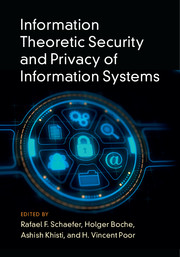Book contents
- Frontmatter
- Contents
- List of Contributors
- Preface
- Part I Theoretical Foundations
- Part II Secure Communication
- 5 Secrecy Rate Maximization in Gaussian MIMO Wiretap Channels
- 6 MIMO Wiretap Channels
- 7 MISO Wiretap Channel with Strictly Causal CSI: A Topological Viewpoint
- 8 Physical-Layer Security with Delayed, Hybrid, and Alternating Channel State Knowledge
- 9 Stochastic Orders, Alignments, and Ergodic Secrecy Capacity
- 10 The Discrete Memoryless Arbitrarily Varying Wiretap Channel
- 11 Super-Activation as a Unique Feature of Secure Communication over Arbitrarily Varying Channels
- Part III Secret Key Generation and Authentication
- Part IV Data Systems and Related Applications
- Index
- References
11 - Super-Activation as a Unique Feature of Secure Communication over Arbitrarily Varying Channels
from Part II - Secure Communication
Published online by Cambridge University Press: 28 June 2017
- Frontmatter
- Contents
- List of Contributors
- Preface
- Part I Theoretical Foundations
- Part II Secure Communication
- 5 Secrecy Rate Maximization in Gaussian MIMO Wiretap Channels
- 6 MIMO Wiretap Channels
- 7 MISO Wiretap Channel with Strictly Causal CSI: A Topological Viewpoint
- 8 Physical-Layer Security with Delayed, Hybrid, and Alternating Channel State Knowledge
- 9 Stochastic Orders, Alignments, and Ergodic Secrecy Capacity
- 10 The Discrete Memoryless Arbitrarily Varying Wiretap Channel
- 11 Super-Activation as a Unique Feature of Secure Communication over Arbitrarily Varying Channels
- Part III Secret Key Generation and Authentication
- Part IV Data Systems and Related Applications
- Index
- References
Summary
The question of whether the capacity of a channel is additive or not goes back to Shannon, who asked this for the zero-error capacity function. Despite the common sense that the capacity is usually additive, there is surprisingly little known for non-trivial channels. This chapter addresses this question for the arbitrarily varying wiretap channel (AVWC), which models secure communication in the presence of arbitrarily varying channel (AVC) conditions. For orthogonal AVWCs it has been shown that the strongest form of non-additivity occurs: the phenomenon of super-activation. That is, there are orthogonal AVWCs, each having zero secrecy capacity, which allow for transmission with positive rate if they are used together. Subsequently, the single-user AVC is studied and it is shown that in this case, super-activation for non-secure message transmission is not possible, making it a unique feature of secure communication over AVWCs. However, the capacity for message transmission of the single-user AVC is shown to be super-additive, including a complete characterization. Super-activation was known for a long time in the area of quantum communication, where it is common opinion that this is solely a phenomenon of quantum physics and that this cannot occur for classical communication. However, the results in this chapter show that super-activation is indeed a feature of secure communication and therewith occurs in classical, non-quantum, communication as well.
Introduction
Information theory goes back to Shannon's seminal work “A Mathematical Theory of Communication” [1]. Since then it has been proven to be an indispensable concept for analyzing complex communication systems to obtain insights and optimal design criteria. Among many things, it is used to address the important issue of medium access control: How should available resources be divided among multiple users in the best possible way? This is a crucial question, especially for wireless communication systems since they are usually composed of orthogonal sub-systems such as those that arise via time division multiplexing (TDM) or orthogonal frequency division multiplexing (OFDM). Of particular interest then is to know how the capacity of the overall system depends on the orthogonal sub-systems. Common sense tells us that for such systems it should be given by the sum of the capacities of all sub-systems. This goes along with the inherent world view of the additivity of classical resources.
- Type
- Chapter
- Information
- Publisher: Cambridge University PressPrint publication year: 2017

